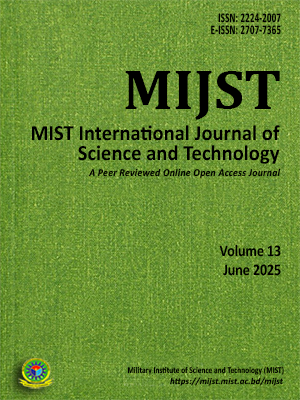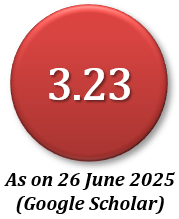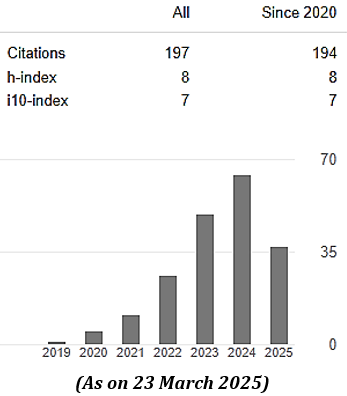The Influence of Silt Layer Orientation on Slope Stability in Shale Formations
Abstract
Shale rock masses often include silt layers, impacting slope stability in construction and mining. Analyzing their interaction is crucial for long-term stability. This study used an elasto-plastic model, incorporating the stress transfer method and Coulomb's criterion. It computed stress distribution, assessed failure potential, and identified vulnerable regions. A shale rock mass ranging from 14.75 to 16.75 meter thick, with silt layers varying from 0.36 to 0.5 meter thick was considered in the model. It examined four silt layer conditions: horizontal (SilHL), vertical (SilVL), in-facing (SilIN), and out-facing slope (SilOUT). Mechanical parameters like Uniaxial Compressive Strength (UCS), Tensile Strength (TS), and Young’s modulus (E) were adjusted for varied scenarios: UCS (0.5 to 5 MPa), and E (6 to 60 MPa), keeping UCS/TS = 5 for all the conditions. In the elasto-plastic analysis, overall reductions of 20%, 40%, 60%, 80%, and 90% in E, UCS and TS were evaluated, taking into consideration the temporal degradation. The findings for SilHL indicate that: (i) when the E, UCS, and TS of the silt layer and shale were equivalent, significant structural failure occurred at 60% reduction, with pronounced collapse at 80% and complete failure at 90%; (ii) a lower E in the silt layer with equivalent strength to shale showed no significant differences; (iii) reductions in both E and UCS for the silt layer also revealed no notable differences. For SilVL, the results were similar, with (i) consistent effects as SilHL; (ii) slippage occurring with a lower E for the silt layer; and (iii) bitension failure and toppling observed when the silt layer's strength was one-tenth that of shale. In SilIN, similar patterns emerged, with slippage and tension failures noted under reduced E and UCS conditions. For SilOUT, results mirrored SilHL, with tension failures and divergence in failure patterns under reduced E and UCS. The results of this study indicate that slope failure scenarios involving shale with a silt layer can be effectively simulated using the elasto-plastic method, particularly by incorporating reductions in strength and Young’s modulus. Furthermore, these findings highlight the critical need for additional research on specific slope configurations to refine design methodologies and enhance stability assessments within the context of the elasto-plastic model.
Downloads
References
Akai, K., & Hori, M. (1978). Fundamental study on instability of tunnel in consideration of post-peak strain softening behavior of rock. Memoirs of the Faculty of Engineering, Kyoto University, 40(2). http://hdl.handle.net/2433/281068
Akoudad, A., Asmi, H. El, Qandil, M. El, Zian, A., Senhaji, A. S., Zandar, S., Darkik, I., Marzouki, A., & Bargach, K. (2024). The Role of Geological and Geotechnical Factors in Shale Slope Instability: Case of Landslides on Road Embankments, Tizi Ouadrene Sector-Rif Extern, Morocco. Iraqi Geological Journal, 57(1), 83–97. https://doi.org/10.46717/igj.57.1B.7ms-2024-2-16
Alam, A. K. M. B., Fujii, Y., Islam, N., Rahman, M. A., Hasan, A. Al, & Hasan, M. A. (2021). Stability of shale at a slope. IOP Conference Series: Earth and Environmental Science, 861(6). https://doi.org/10.1088/1755-1315/861/6/062010
Bishop, A. W. (1955). The use of the slip circle in the stability analysis of slopes. Geotechnique, 15(1), 1–24.
Deris, A. M., Solemon, B., Taha, H., & Omar, R. C. (2020). Determination of influencing factors for slope stability using grey relational analysis (GRA) technique. Systematic Reviews in Pharmacy, 11(4), 202–206. https://doi.org/10.31838/srp.2020.4.29
Ding, Y., Liu, X., Liang, L., Xiong, J., Li, W., Wei, X., Duan, X., & Hou, L. (2023). Wellbore stability model in shale formation under the synergistic effect of stress unloading-hydration. Petroleum Exploration and Development, 50(6), 1478–1486. https://doi.org/10.1016/S1876-3804(24)60481-7
Duncan, J. M., Wright, S., & Brandon, T. (2014). Soil Strength and Slope Stability, 2nd Edition. John Wiley & Sons.
Fell, R., Corominas, J., & Bonnard, C. (2005). Guidelines for landslide risk assessment. International Journal of Landslide, 12(2), 101–115.
Harabinova, S., & Panulinova, E. (2022). Numerical analysis of slope stability. IOP Conference Series: Materials Science and Engineering, 1252(1), 012084. https://doi.org/10.1088/1757-899x/1252/1/012084
Hulagabali, A. (2019). Numerical Analysis of Slope Stability- A Parametric Study. International Journal for Research in Applied Science and Engineering Technology, 7(1), 319–324. https://doi.org/10.22214/ijraset.2019.1056
Lee, C., Kim, J., & Park, H. (2015). Field investigation of slope failures in shale rock masses with silt layers. Engineering Geology, 187, 1–12.
Li, H. (2022). Research progress on evaluation methods and factors influencing shale brittleness: A review. In Energy Reports (Vol. 8, pp. 4344–4358). Elsevier Ltd. https://doi.org/10.1016/j.egyr.2022.03.120
Li, H., Lai, B., & Lin, S. (2016). Shale Mechanical Properties Influence Factors Overview and Experimental Investigation on Water Content Effects. Journal of Sustainable Energy Engineering, 3(4), 275–298. https://doi.org/10.7569/jsee.2016.629501
Mehrabian, A., Nguyen, V. X., & Abousleiman, Y. N. (2019). Wellbore Mechanics and Stability in Shale. Shale. https://api.semanticscholar.org/CorpusID:210737337
Wen, S. L., Hai, B. La, & Chang, Z. W. (2012). Analysis of Influence Factors of Slope Stability. Applied Mechanics and Materials, 34, 256–259. https://doi.org/https://doi.org/10.4028/www.scientific.net/amm.256-259.34.
Zhang, F., Cui, L., An, M., Elsworth, D., & He, C. (2022). Frictional stability of Longmaxi shale gouges and its implication for deep seismic potential in the southeastern Sichuan Basin. Deep Underground Science and Engineering, 1(1), 3–14. https://doi.org/10.1002/dug2.12013
Zhang, Y., Li, X., & Wang, J. (2018). Numerical simulation of slope stability considering silt layers in shale. Computers and Geotechnics, 101, 52–62.
MIJST follows the open access policy.

This work is licensed under a Creative Commons Attribution-NonCommercial 4.0 International License. This allows anyone to copy, share, distribute, and modify the work for non-commercial purposes, where the original work and source should be properly credited.
















